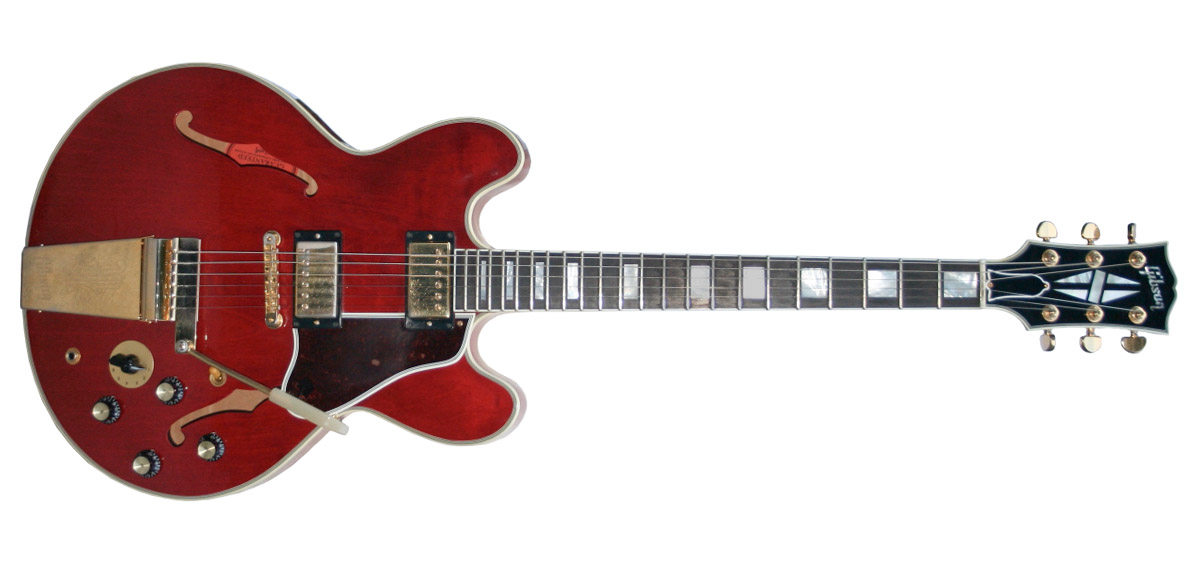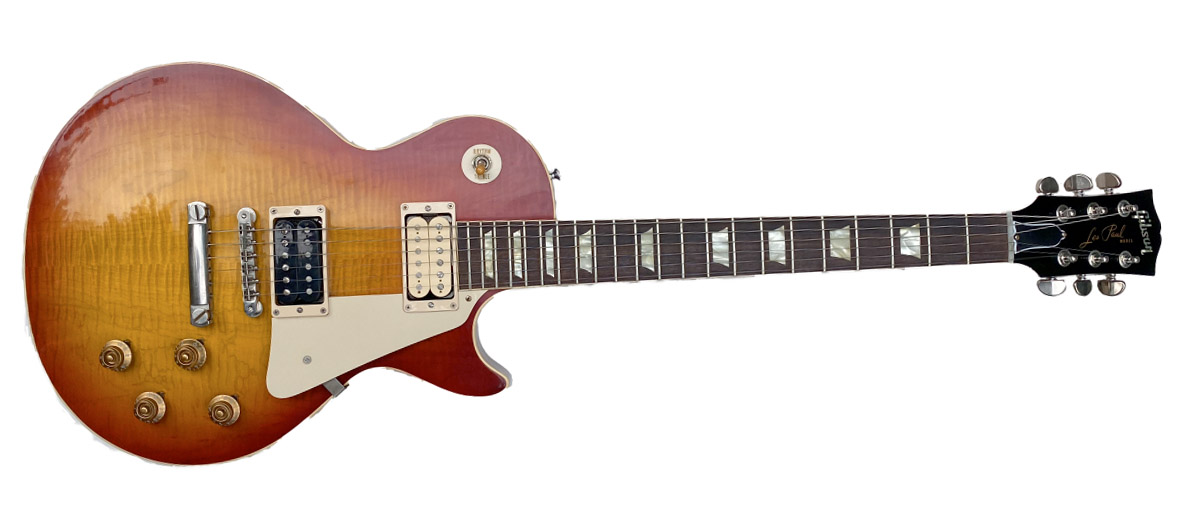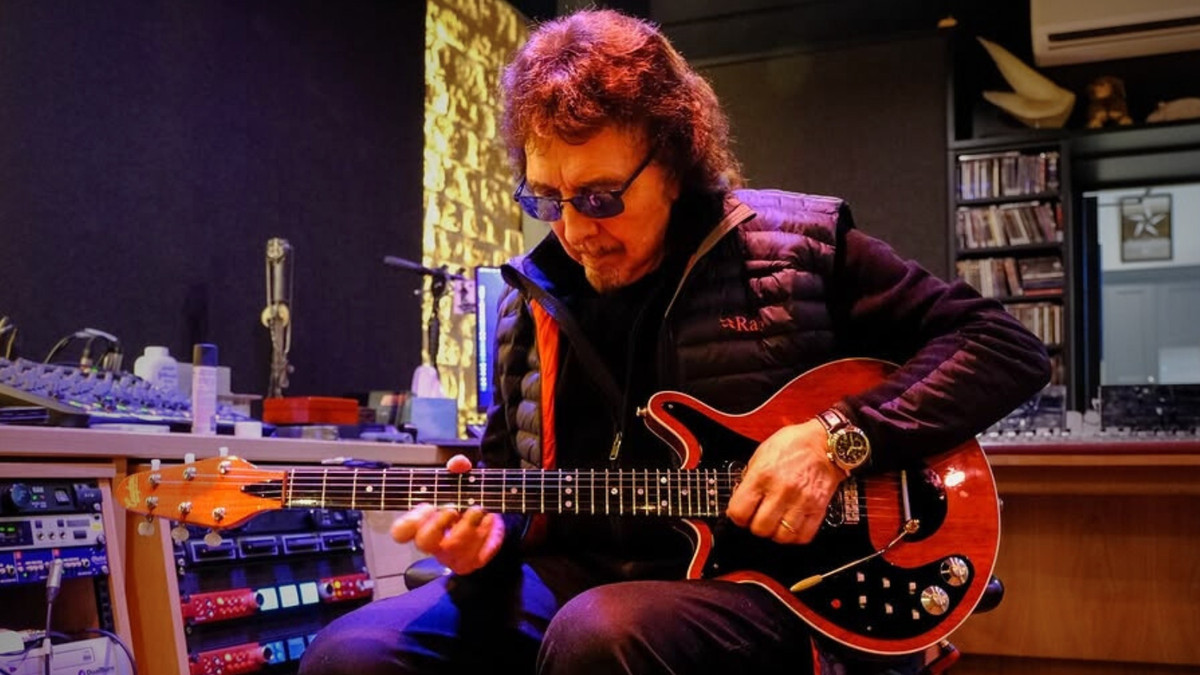Stephen Dale Petit on Mick Taylor's Magic Presence, Blues in 2020, and Harnessing the Power of a Vintage JTM45
SDP's long-awaited new album is a stylistically adventurous work of blues that's in tune with our troubled era.

Stephen Dale Petit's 2020 Visions has been a long time coming and now that it's here, and now that 2020 has shown its hand, he's allowing himself a wry smile as to its prescience.
“The mood of the album is a perfect fit for what we are actually living through right now,” he says from his home in West Hampstead, north-west London. It sounds like he can't believe his luck. Maybe that's true, but not in the way we might imagine.
Tracking started in 2017, ready for a summer release the following year when Petit was diagnosed with cancer and everything was put on ice. Now, mercifully, having had the all-clear for over a year now, the record was scheduled to hit shelves in the last week of March, before lockdown happened and everything shut down.
Dates were pulled, we all hid away, and all that was left was to tell the story how we got here. “Whilst it was devastating to have all the dates disappear, the album launch, and all the things that went with it, it wasn’t my first go-round on this rodeo because I have had to pull things for health reasons," he says. “Different context!“
SDP can't take credit for predicting a global pandemic but 2020 Visions does an exemplary job in articulating this febrile, combustible moment on planet Earth. And maybe it just happens to exorcise some of the anxieties that Petit has had to live in recent times.
I just can’t get enough of how the JTM45 behaves when you are sustaining notes and feeding back
“There are a few overriding themes that I wanted the album to contain,“ says Petit. “One, I wanted it to be kind of a tribute to the bent note on a guitar. I spoke with the band and the producer a lot to hopefully come up with the sound experience that was fresh.
“My hypothetical was, ‘What was it like to hear “Satisfaction“ for the very first time?’ Like we are so used to it, and it is such a familiar sound, but when it came out nothing had ever sounded like that before that record. It’s easy to forget how, sonically speaking, how revolutionary that was."
All the latest guitar news, interviews, lessons, reviews, deals and more, direct to your inbox!
As Petit explains here, everything on the record is born of the blues, but it doesn't necessarily stay blues — throughout, he finds little pockets of inspiration, permission to take it somewhere else.
These moments just happen, as on tracks such as “Zombie Train,” which was captured in one live, jam-band go-for-it take on which producer Vance Powell fished keyboardist Daniel Ellsworth out of his Nashville Rolodex to sit in and complement Petit's trio.
“I am seriously so pleased with capturing that,” he says. Petit is joined on the recording by bassist Sophie Lord and drummer Jack Greenwood. There are other guest performances — the brilliant Shemekia Copeland sings on “Soul of a Man” — but having a trio as the core allowed each of them to stretch out and play with the boundaries of blues.
It even goes (almost) metal; only for 20 seconds but that's very much of a piece with the spirit guiding the record. On 2020 Visions, Petit lets the songs chase their own logic. Petit, for his part, was just trying to stay on good terms with his JTM45 and appeal to the better angels of its nature. A skill that takes some mastering...
We talk about you as a blues artist, and everything flows from the blues, but you take it to different places. Tell me about “The Fall of America.”
I had been to see the Kills, the band, and Jamie Hince does quite a lot of things where he is fretting — like blues — with his thumb, and he has some cool things going on. I saw them at the Brixton Academy. I thought, ‘Well I never want to copy…’ But I did! I hooked my thumb around the low E and just started to see what happened, and an hour-and-a-half later the riff has been born.
It was inspired by the moment. Mick Taylor — the Rolling Stone, Bob Dylan and Jack Bruce guitar player — was living with me at the time, and he was in another part of the house. He had gone away to get tea and he came back, listening the whole time. The mere act of the music going through his ears and being filtered by his brain changed the molecules of the music in the air somehow.
Just by his very presence?
I don’t know why it felt like that but it did. It was almost like he was a human piece of high-end kit. [Laughs] I’m not making this up! It was a very distinct, visceral experience. His only contribution to this, other than that was to say, ‘Well I think it has to go to E at some point.’ And it goes to E at the end.
How come he was living in your house?
Well he just came and lived at my house whenever he was in London. I don’t know, we are just pals!
Did he contribute anything else?
He wrote “Sputnik Days” with me in a similar sort of fashion, but on that particular occasion he felt strongly enough about it, and there was a guitar to hand, so he picked it up and we just finished the song that way.
That track has some great tones going on.
Yes, love the tone. That was Vance Powell, an absolute sonic genius and one of the best. He’s in the top five recording men on the planet, the Sam Phillips or Tom Dowd of his age, and he loves tape delays. The guitar sound on that would have been the 355.
I’m not sure if I was using the Varitone, but certainly middle position on the pickup toggle switch, and to get that sound you are just dialing in the volume of the two pickups to what seems to work. Something we must touch on is the contribution that my amp made, which is a JTM45 that was manufactured in 1965, and so the way the guitar feeds back on this album is quite special for me.
I just can’t get enough of how the amplifier behaves when you are sustaining notes and feeding back. They morph and shift, and the harmonics are so varied. I think there is one note on the very top end of “2020 Visions” where it goes through seven iterations. It’s the same note but the harmonics feed back and then it goes to the actual note and then, yeah! It’s a force of nature.
Harmonics can be a strange phenomenon, like an accident of science.
Yeah, and I hate to say it, because it is a very expensive piece of kit, but there are not many modern amps that can do it. I mean, you can get a modern amp that will get you two or three permutations but that Marshall you could easily go through 10 if the music allows the note to resonate that long. It will just shift forever.
Because of how it was made at the time.
Yes, absolutely. And you can get into proper geekery but it is down to the Radiospares transformers. This one has all Radiospares for the choke and the power and the output stage. I had it authenticated before I spent the money. There is a guy at Marshall whose only job it is vintage certification.
“The Fall of America” was written around the riff; that’s how it was born, and I wanted it to sound otherworldly, and to sound ominous and threatening
It sounds great. You have to spare a thought for today’s amp builders. They’ve got the knowledge, but access to parts is another thing entirely.
Yeah, absolutely. You can still get great sounds but I was really interesting in chasing the results in what this amp offers. You have to work with it. When I first played with one, it was really upsetting because I had been told about this mythic amp, and the first time I played through one it was a combo. They knew I would be salivating, so they really hyped it up.
I was looking forward to this session for like a month, and I went in, and I was so discouraged! And so upset! Because I was used to modern amps, where if I hit a note and sustain it, it behaves kind of predictably. This thing wouldn’t cooperate. You had to work.
I thought I was going to be like a kid in a candy shop; it was a really hard day of work. You’d hit a note, try and sustain it, and it would stop dead. Other times it would sustain in a way that you didn’t expect it to, or wanted it to.

When did you change your mind on it?
When I went back that night and listened to the monitor mixes. If you think about it there is a commonality with, say, Hendrix’s first album, Beano, the early Cream, and even Mick Taylor on Crusade, which is ’67, there was a commonality with how the bent notes would sound, the way that they sort of arc, and the reverberations out of a bent note, have a very peculiar characteristic.
There are commonalities, as much as they are all different. Also Peter Green, on the John Mayall stuff... They are all playing through '60s Marshalls. And I heard it in that monitor mix. I could hear that tone, the tone! It’s insane.
You have to have it six or above for it to function properly. As they say in America, everything should be dimed. Everything on 10
And it made sense?
Once I understood, I asked for another bout, a rematch. [Laughs] Because it did feel like a fight. It was really nothing like I was expecting. So then I learned. Okay, this is what it does and this is what it doesn’t do. In terms of sustaining notes and so forth, the feedback, it would coax you out onto a branch and then break the branch off.
Now, if you knew that was going to happen you could fly, but the first time I was falling flat on my face. When you begin to get a handle on how it behaves, then all of a sudden you are flying. Wow! That’s how it is, and that’s how I ended up getting this amp.
An amp like that is like breaking in a horse.
Yeah, and you don’t wanna tame it too much.
Do you use rely on your guitar's tone and volume controls to rein it in?
Yes, certainly with the Marshall. You have to have it six or above for it to function properly, all those components I was talking about. They don’t really come into play until you’re cranked up to a significant degree — and I think that, as they say in America, everything should be dimed. Everything on 10.
I also tend to go for the middle position on the toggle switch and play with the two volumes, before I even touch a tone control. I’ll play with the volumes to get something that’s interesting, or that makes sense for the section of the song.
And you have got the Varitone on your ES-355...
I use the Varitone on the 355. It’s gorgeous. Again, it is something that at first seems really odd and clunky, and weird, and why only five positions on an EQ? It’s very savage, but I think it is beautiful on that guitar; you can get some really clear bell-like tones.
Everybody talks about the Peter Green mistake and the rewiring of the pickup that gave him his famous tone, but I don’t know. These discussions are myths really, and what any guitar player from that period remembers, in 1973, and then what they remember when they are asked 30 years later, who knows?
I think he was just chasing B.B. King and he had a Les Paul. It made more sense if you are trying to drive around the neighborhood of that tone, to get a 355 with a Varitone because that’s how B.B. King did it, and sure enough it is very similar to the legendary Peter Green out-of-phase pickup tone.
I use the Varitone on the 355. I think it is beautiful on that guitar; you can get some really clear bell-like tones
What were you using on “On Top”?
I was using the 355. I wanted to have something that was that vintage of blues, and I just loved the idea of using it as an intro to something as rough and ready as the song that follows it, “Long Tall Shorty,” which has got some savagery about it.
Back in the day, the top line of “On Top” would have probably been played by horns or clarinet and then Sophie came up with a genius bass part, harmonically covering the territory of a horn section, piano and bass all at once by chording the whole song, including shifting note clusters and counterpoint melodies, which any guitarist will know, is insanely difficult on bass.
Was that through the Marshall?
Through the Marshall, but dialed back. I also use an Ernie Ball volume pedal, and in the studio, that’s probably not used as much as it is onstage, but I would definitely would have had the middle toggle position and favoring the neck pickup in terms of volume, and neither of them much beyond eight, seven-and-bit, and maybe dial down a little bit of tone.
It sounds so sweet.
It is sort of cheeky. I definitely like the juxtaposition. Stylistically there might be a bit of tension but in terms of the content of the music it is exactly the same.
The risk with an audience is that they can second guess things, and that can be very difficult in blues. You really go for it with those dynamics on “Long Tall Shorty.”
Sure. I guess to go for something stylistically like they were doing in the ‘20s and ‘30s and ‘40s, and then try and create what they would be trying to do in 2030, but with the same blues DNA. Everything is born of the blues.
I just think the bass groove that Sophie lays down at the top of the song is so sexy, and raw, and badass, and moody with it — it sets the mood and then the drums come in and right then you’ve got the template for the whole song, and then this guitar comes over the top and just slices through. That was a Les Paul.
That again is a different mood to something like “The Fall of America,” which is all kinds of antsy, anxious.
“The Fall of America” was written around the riff; that’s how it was born, and I wanted it to sound otherworldly, and to sound ominous and threatening. Anxiety for sure. We worked hard to get the drum beat that felt right, we tried all kinds of different feels and it is actually really similar to the old-style marching band blues shuffle from the ’30s. It just ended up being that. I was really chuffed. The lyrics were something that I at first thought, “I can’t go **** there, can I?” But, sure enough…
When you find yourself asking the question, “I can’t go there, can I?” the answer is invariably yes.
Well! And you just hit upon part of the guidelines for making this, which was, yes, everything is born of the blues but any time a song felt like it wanted to expand and not stay in its lane, I didn’t stop it. To let the song have its own head, so to speak. The end of “The Fall of America” is kind of just like metal.
Change the guitar tone, the tempo, and it could be Iron Maiden, almost.
Yeah, and I just thought, “Fine!” I mean, I know that Black Sabbath started out as a blues band. Does that matter? I don’t know. Is their fifth album in blues? No, but it makes sense. I am fine with that, and we were just passing through anyway — that section only lasts 20-odd seconds and then it goes into something else… A band simultaneously exploding and imploding into itself...


Petit's Gibson ES-355.

Tell us about “Soul of a Man.” When you have a vocalist such as Shemekia Copeland, does that change your playing?
Sometimes, yes. In this instance, no. Because you’ve got “2020 Visions,” “The Fall of America,” and “Zombie Train” that are specifically dealing with kind of an alienated, post-dystopian approach to what it is like to live life in that atmosphere — which we are all getting an experience of now — it was another of those songs that needed to be where it was.
“Soul of a Man” was there because it is right there in the words: it was asking a really important question. It's trying to address, factionalism and tribalism, who shouts the loudest.
Like you said, “Roxie’s Song” needed to be where it was, to have something calming and soothing, a ray of sunshine. Even though it is a song about loss, it has a lot of really joyful moments in it, and the majesty of when you bond with people, or any creature on the planet really, there is a lot of magic. It is a song of mourning but I also wanted to celebrate the magic on “Roxie’s Song.”
I don’t think that live music and people’s need for it is going to stop. I do not think streaming from your settee in your front room or anywhere is the answer
This is an exceptional situation, but there have always been pressures on venues — with rents, property developers, etc. I wanted to ask you just how important music venues are to the music? We talk amps, pedals, transistors 24/7, but the physical spaces we perform and experience music in are just as crucial.
That’s a great question and you sort of answered it in the question because it is exactly like those particular components in an amp, or a personality. Even though it is bricks and mortar, a venue is a living, breathing entity and so, up and down the country, there are venues that are super-massively special. The Astoria? It’s insane that is gone. The 100 Club exists. I’ve had an affinity with that place ever since I moved to London, a long time ago, decades…
But there are other places up and down the country. There is the Picturedome in Holmfirth. I don’t want to name some and then others get left out but, yes, massively important. I don’t know what resources and forces and influence can be brought to bear to make sure that the decimation of the number of places to perform live music that has already occurred in the last decade doesn’t continue.
I don’t think that live music and people’s need for it is going to be stopped. It might be that other venues need to have to open up. I do not think streaming from your settee in your front room or anywhere is the answer. It’s great for the moment. It has helped enormously. But it is certainly never going to replace people being in the same room with molecules of music moving about.
- Stephen Dale Petit's 2020 Visions is out now via 333 Records.


